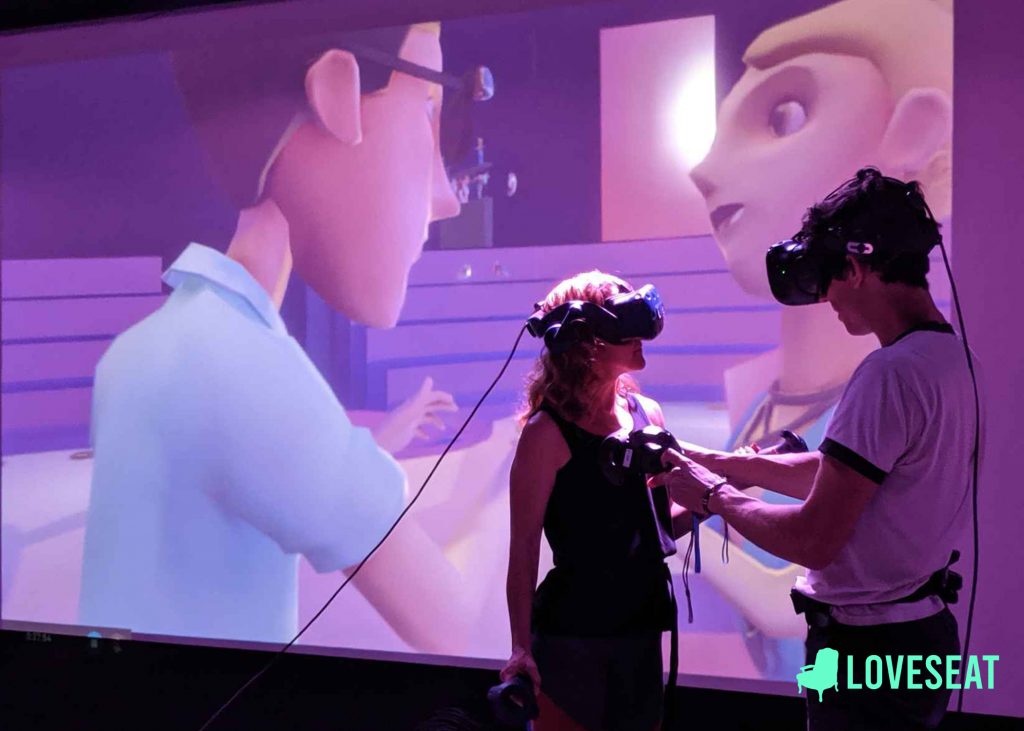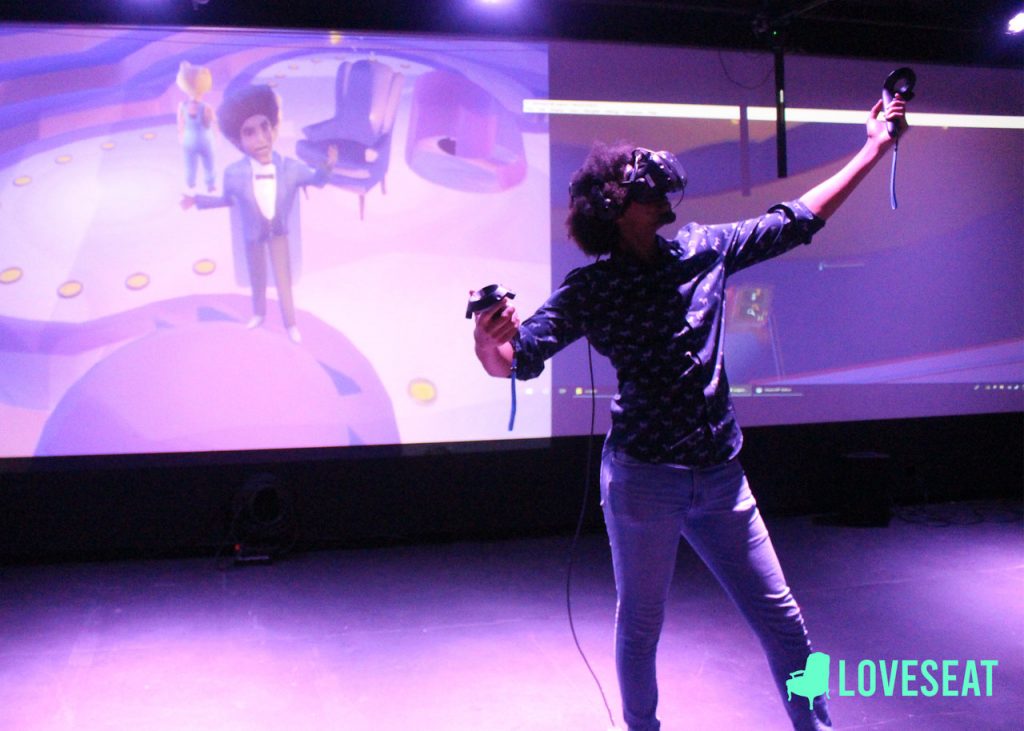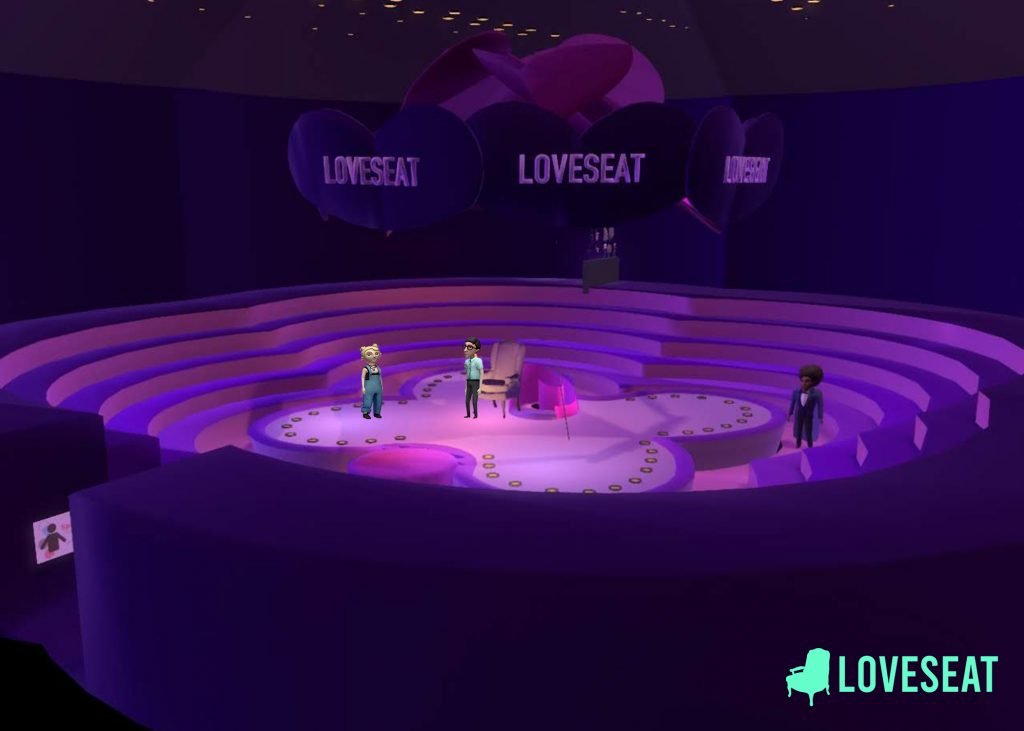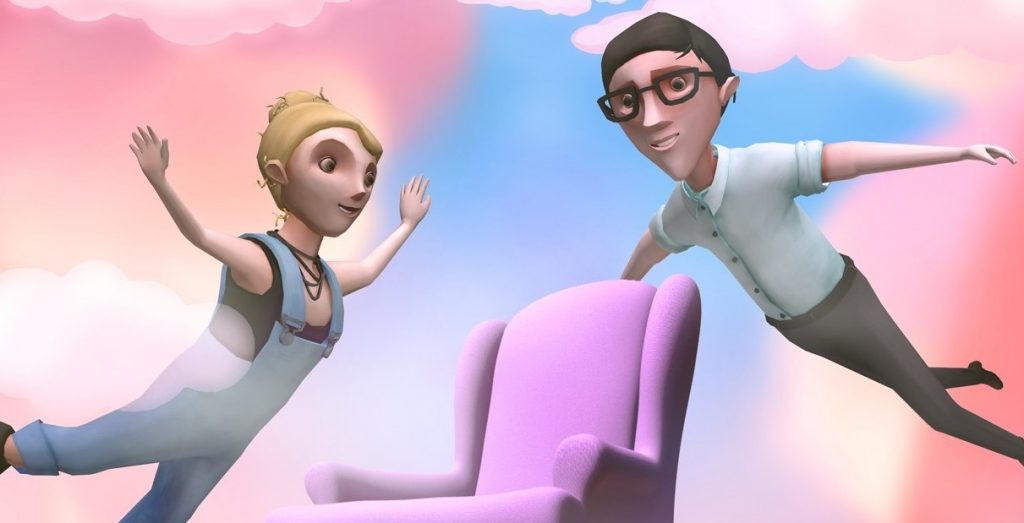At 2019 Venice Film Festival, Loud and Clear and Fanheart3 interviewed Loveseat director Kiira Benzing and cast members Sam Kebede, Jenn Harris and Jonathan David Martin.
Part-story and part-interaction between virtual and real worlds, Loveseat gives a whole new meaning to Virtual Reality by doing something that no one has ever done before. By enabling different kinds of audiences to connect with each other in a space that is made of both stunning VR graphics and compelling live performances, this impressive “Virtual Theatre Performance” gives us a one-of-a-kind experience that is as enjoyable as it is genuinely endearing and surprisingly meaningful.
This groundbreaking VR installation comes in the form of a talk show in which “two lonely, ordinary people” are chosen to compete for the love of an empty armchair, which stands to represent their Perfect Partner. No VR gear is necessary to join this very special reality show, and yet the experience is as immersive and virtual as they come. In this entertaining and moving story, everything happens live and has been carefully constructed to give us what can only be described as a play disguised as a Virtual Reality experience that takes place on a whole new kind of stage.
“It’s like the movie Avatar, but if the cast was in the theatre with you”
Sam Kebede (“The Host”)
We had the chance to experience Loveseat at the 2019 Venice Film Festival, and we joined forces with our friends at Fanheart3 to bring you a very special interview. Fanheart3 is a cultural association which is very close to our heart, as not only does it celebrate fan culture, but it is in charge of three official collateral Awards of the Venice Film Festival itself (Read all about it at Fanheart3!).
Fanheart3 President Agnese Pietrobon and myself interviewed director Kiira Benzing and cast members Sam Kebede, Jenn Harris and Jonathan David Martin on Loveseat: here’s what they told us on their impressive Virtual Reality experience.

Loveseat: Avatars, Flying and Social VR
How would you describe what we’ve just experienced in one sentence?
Jonathan: Loveseat is a work of VR theatre, and it’s the only piece I know of that performs live for both the audience that’s in the room with the actors and the audience that is online watching a virtual play.
Sam: It’s like the movie Avatar, but if the cast was in the theatre with you and the two worlds could talk to each other.
Jenn: It’s a VR theatre that’s a dramedy, and you can choose to be in the audience either virtually or in real life.
…Which is really part of what’s so great and unique about Loveseat! It’s closer to theatre than it is to what you would usually associate both Virtual Reality and talk shows with! How did the project take shape?
Kiira: I’ve been wanting to mix theatre and VR for a long time, and I do it in some other pieces that I have been building, and taken a long time to build. I started working with playwright Mac Rogers in New York: about a year ago, I was bringing him into some research that I was doing with a platform called High Fidelity, which is a social VR world.
With a team in New York and some other colleagues, we write a blog called Alive in Plasticland. I started to explore what actors need for best performance, and my hypothesis were correct, but my research led me even further: they don’t need to be photo-realistic. They don’t need to look human. In fact, it’s better to step away from that: it helps us leave more to our imagination.
“I always think that theatre should help us feel”.
Kiira Benzing
There are a lot of things that I’ve been wanting to do in the VR space, and one of them was writing something original with Mac [Rogers] that could take advantage of the possibilities in VR. We can fly and the actors are physically safe. Jenn has learned how to fly in VR, which is an interesting psychological thing because… I bet it feels like you’re flying!
Jenn: It does feel like I’m flying! It actually does!

Kiira: She does all that herself: we don’t control that. She’s learned how to navigate through the virtual three-dimensional space. And Jonathan, Sam and Jenn all have to do these quick costume changes, and they also do all of that themselves. There’s an additional skill set that they’ve learned to be able to have this ability to perform virtually.
I have a lot of hopes for social VR. I’ve been spending time in those worlds and I think that they are all in need of meaningful content that has the capability to move someone. The possibility of having a community gathered together, to watch something together – like we have, for many years, in cinematic, theatrical and performance and dance-based tradition – these are things we love to do as humans, and we need more of that in Social VR.
My other dream is to bring these communities together. We’re starting with some of that in the pre-show: we’re not fully there, but it’s a good step.
“Really, what we’re doing is a puppet show!”
Jonathan David Martin (“Bruce”)
Performing in Loveseat: becoming a master puppet maker
What was the main challenge of bringing theatre performances to a Virtual Reality environment?
Jenn: I would say the technical maneuvering: moving around while also speaking and doing a scene… For example, I have to listen to my scene partner, and at the same time I also have to fly. And then there are sound cues… It’s just navigating all that at the same time. It’s so tricky, but it’s amazing: it’s just a different skill set!
Sam, you have to do even more than this, as you are the host, so you also have to keep the audience engaged.
Sam: I had the benefit of being a video game player all of my life! [laughs] It wasn’t the mechanics that really got to me, but I get nauseous easily if the whole world shifts. Sometimes we’re working and, for example, in VR there’s an earthquake but, in reality, you’re not moving. It’s a weird concept that sometimes happens in VR: that, to me, was the hardest thing.
I’ve worked crowds before, but another difficult thing is that the virtual audience can’t talk yet, so I’d be like… “How are you?” [enthusiastically] and no answer would come back.

Jonathan, you also took part in the Broadway production of War Horse, which is also groundbreaking both in terms of set up and props and in the way you connect to the audience.
Jonathan: Yes, there are similarities there. Really, what we’re doing [in Loveseat] is a puppet show! At least, for the virtual audience: avatars are really puppets of ourselves. There’s a little bit of a learning curve about the way these puppets communicate. These avatars don’t capture our facial expressions as actors, but they’re very expressive with their limbs.
You have to figure out the best way to communicate physically through those puppets, in the way that they like to move. I spent a lot of time in rehearsal watching the other two [characters] and learning what worked well in terms of how they gestured, how they moved, and also figuring that out for myself.
“The more we have the capability to connect with technology, the more isolated we often feel.”
Jonathan David Martin (“Bruce”)
One way that these avatar puppets are different than the puppets from War Horse is that, in War Horse, besides the fact that you’re creating one character with multiple people, you’re also working very much by touch – how the puppet feels and responds. Here, it’s frictionless. I hit a button and a move happens. I move my arm and it happens, but I don’t feel any strings attached.
You get different information from the puppet, and this is a new, fun learning curve. There’s no “Master Puppet Maker/Designer” who comes in and goes, “Ah, here’s how this thing works!”. You really have to figure out the vocabulary yourself.

Connecting with Loveseat’s multiple audiences
Loveseat really moved me, and I also found the dynamics of the VR “play” really interesting. It takes place in an extremely “public” environment – not only is it a talk show, but it’s in VR, and that usually implies more involvement in the audience. At the same time, part of the message I got from this experience has a lot to do with isolation and loneliness.
What is the main message you’d like people to get from Loveseat?
Kiira: I always think that theatre should help us feel. We’re in a place of comedy, but there are some more serious moments of loneliness. I’ve been hoping they walk away with a kind of warm and fuzzy feeling: that’s the core feeling. But if they think about it, there’s also a sense of our “connectedness” to each other.
They are looking at themselves and at what they might project into that empty chair – the way Bruce and Abby do throughout the show, and the way the host finally admits he does to. Since we do this in a VR piece, the audience can do their deep reflection on what they see in a perfect partner, so, as they think about these things, they go pretty deep into those things, as they also remember that we are connected in these very social spaces.

Serena: It’s so interesting that you chose to have an empty seat! When you see an armchair, you’d expect somebody to sit on it at some point.
Agnese: The two components of loneliness and connection can go together: every one of us is lonely, but we are also all looking at the chair together. This enables us to look beyond the loneliness: there’s a connecting line between all these steps!
Jonathan: I think there’s something in the conversation between the people who are physically in the space and the people who are together in a virtual space. I think it’s about saying that those two worlds – and those two sides of our personalities – aren’t so separate. What’s more real, your online life or your offline life? I think the answer is that it’s much muddier. Technology and the ways we’re using technology are bringing us together in really interesting ways. This really addresses that issue of isolation, and it’s a funny paradox: the more we have the capability to connect with technology, the more isolated we often feel. Projects like this “mess” with that in a really good way.
Sam: One of the lines I say is, “To leave me and this fantasy, I’m pedaling far behind”. It’s the big idea behind chance versus design – the difference between what we imagine and what’s real in terms of our desires. As we progress more towards Virtual Reality, we get to choose exactly the way things would want to be in our minds instead of enjoying the lovely surprise of whatever can occur. That is a big part of what I hope people will leave with, not only when they leave this theatre but also as they perceive romance, love and the people in their lives.
“It’s so tricky, but it’s amazing: it’s just a different skill set!”
Jenn Harris (“Abby”)
Loveseat: what’s next
What’s next for Loveseat?
Sam: …A Broadway show and multimillion dollar movie bill! [laughs]
Kiira: We can certainly turn it into a musical: Mac [Rogers] has not written with music, but he told me he was willing! I tend to have dance sequences in all my work, so I keep joking that we’ll just have to add a dream ballet to our next version. We would love to be at more festivals, and certainly a New York and LA run are things that are in my head, so if we could bring them into this reality… that would be really nice.

Loveseat is currently competing at the Venice Film Festival, as part of the Biennale’s Virtual Reality programme.

